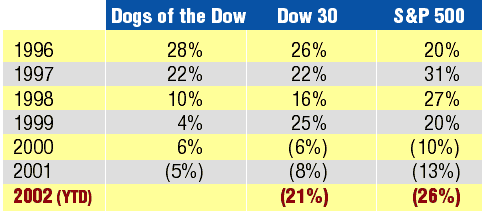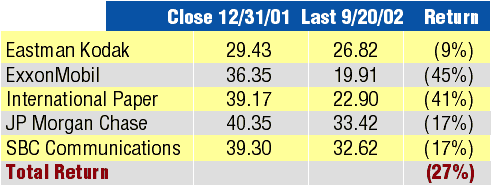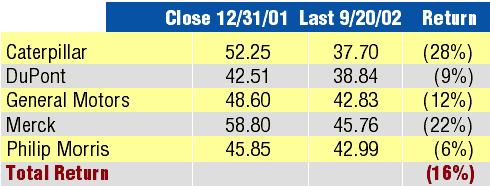
HOT TOPICS LIST
- Strategies
- Stocks
- Buy
- Investing
- Brokers
- Psychology
- Interviews
- Accumulate
- Sell
- Hold
- Spotlight
- Websites
- Candlestick Corner
- Gold & Metals
- Options Trading
LIST OF TOPICS
MARKET COMMENTARY
Bear-Baiting & The Dogs Of The Dow
10/08/02 02:02:52 PM PSTby David Penn
Investing in high-yield, low-priced Dow stocks has been a winning game for years -- with the emphasis on "has been."
| "Bear-baiting" is a cruel fighting-animal sport that is still practiced in remote parts of the world. While there are variations, bear-baiting tends to involve pairs of fighting dogs pitched into battle against a tethered bear — whose teeth have often been removed in an attempt to level the playing field. Once common in the American South, bear-baiting is now (like cockfighting and other fighting-animal sports) eschewed by most civilized people who, truth be told, have never lacked an outlet for indulging bloodlust (it is football season, after all). But there is another form of "bear-baiting" which, while not nearly as cruel, can have equally destructive effects on the participants. This form of bear-baiting is financial — and involves attempts by traders and investors to use successful bull market trading and investing tactics and strategies in a bear market. The first casualties of this type of bear-baiting were the many observers and analysts who claimed buy and hold investment strategies that had produced outstanding returns since 1982 would continue to be viable after the stock market began to drop in 2000. While there are still a few diehard buy and hold investors in the market, most have been driven out by the dismal returns generated in the two and a half years since the market topped. Other strategies have attempted to, if not time the market, then at least provide somewhat active investors with ways of either minimizing exposure to declining markets or picking stocks that are undervalued with the expectation that other investors will over time recognize the value of these stocks and bid their prices up. One of the simplest and most popular versions of this latter strategy is the "Dogs of the Dow" strategy, popularized by Michael B. O'Higgins and John Downes in their book Beating The Dow, first published in 1993. The Dogs of the Dow strategy was subsequently embraced and extended by such stock market cheerleaders as David and Tom Gardner of "Motley Fool" fame, and not without good reason. The Dogs of the Dow strategy can boast of average annual returns in the neighborhood of 17% since 1973. In more recent years, the Dogs of the Dow strategy returned 28% in 1996, 22% in 1997, 10% in 1998, 4% in 1999 and 6% in 2000.
RECENT YEARSBut in fact, recent years have not been especially kind to the strategy, which suffered a 5% negative return in 2001 as the bear market in US stocks finally took hold. Moreover, a closer look at the performance of the Dogs of the Dow strategy compared to a buy and hold strategy suggests that between 1996 and 2001 — the last years of the secular bull market — the Dogs did not provide substantially superior returns.
Figure 1: Comparative returns. Dogs of the Dow versus buy and hold approaches in the Dow 30 and Standard & Poor's 500. There are variations on the Dogs of the Dow strategy. One popular approach involves selecting those 10 Dow 30 stocks with the highest dividend yields. Each of these stocks is purchased and held for one year, after which time the 10 stocks are sold and then another 10 Dow 30 stocks — again with the highest dividend yields — are purchased and held for a year. This process repeats itself annually, and it is easy to see at least some of the attraction of this approach. The Dogs of the Dow strategy is simple and straightforward, and offers the restless investor more opportunity to modify and adjust his or her stock portfolio in pursuit of higher returns. One major variation on this Dogs of the Dow strategy involves finding the 10 highest dividend-yielding stocks and selecting the five with the lowest prices. This variation adds a rather crude but effective value component to the Dogs of the Dow strategy by deliberately seeking out those stocks that have also been driven down in price in the previous year. In looking at 2002, this piece will look at both the "small dogs" (high yield/low price) and the rest of the Dogs of the Dow to see whether there has been, to date, a significant difference in performance between the two types of Dow industrials stocks.
THE DOGS OF 2002The 10 highest-yielding stocks at the beginning of 2002 were Caterpillar, DuPont, Eastman Kodak, ExxonMobil, General Motors, International Paper, JP Morgan Chase, Merck, Philip Morris, and SBC Communications. Of these, the five lowest priced were Eastman Kodak, ExxonMobil, International Paper, JP Morgan Chase, and SBC Communications.
Figure 2: Year-to-date returns of the five lowest-priced of the 10 highest-yielding stocks in the Dow industrials.
While this data takes into account only three-quarters of 2002, the returns of the "small dogs" portion of the Dogs of the Dow are particularly disappointing. Not even the dividend yields of these stocks (these five average a dividend yield of about 3.46%) was much of a salve against a stock price depreciation that cut their value by more than a quarter. The "small dogs" approach — which is admittedly an aggressive take on the traditional Dogs — also underperformed relative to the higher-priced stocks in its cohort.
Figure 3: Year-to-date returns of the five highest-priced of the 10 highest-yielding stocks in the Dow Industrials.
The 16% loss for these "big dog" stocks is certainly better than the 27% loss suffered by those investing in the small dogs, and the 16% loss is also superior in relative terms to a buy and hold approach in both the Dow industrials (down 21% year-to-date) and the Standard & Poor's 500 (down 26% year-to-date). But to some degree we are talking about pulling the wounded from among the dead. The performance of the Dogs of the Dow strategy, as the first chart suggests, has been slipping almost steadily since 1996 — more or less in line with what a Dow 30 or S&P 500 buy and hold investor would have experienced over the same period. Increasingly, it appears that the Dogs of the Dow strategy will be yet another casualty of the bear market that began in 2000 and has been devouring bull marketbased stock strategies whole ever since.
David Penn may be reached at DPenn@Traders.com.
Yahoo! Finance (data); Prophet.net (data)
Current and past articles from Working Money, The Investors' Magazine, can be found at Working-Money.com.
|
Technical Writer for Technical Analysis of STOCKS & COMMODITIES magazine, Working-Money.com, and Traders.com Advantage.
| Title: | Traders.com Technical Writer |
| Company: | Technical Analysis, Inc. |
| Address: | 4757 California Avenue SW |
| Seattle, WA 98116 | |
| Phone # for sales: | 206 938 0570 |
| Fax: | 206 938 1307 |
| Website: | www.traders.com |
| E-mail address: | DPenn@traders.com |
Traders' Resource Links | |
| Charting the Stock Market: The Wyckoff Method -- Books | |
| Working-Money.com -- Online Trading Services | |
| Traders.com Advantage -- Online Trading Services | |
| Technical Analysis of Stocks & Commodities -- Publications and Newsletters | |
| Working Money, at Working-Money.com -- Publications and Newsletters | |
| Traders.com Advantage -- Publications and Newsletters | |
| Professional Traders Starter Kit -- Software | |
PRINT THIS ARTICLE

Request Information From Our Sponsors
- StockCharts.com, Inc.
- Candle Patterns
- Candlestick Charting Explained
- Intermarket Technical Analysis
- John Murphy on Chart Analysis
- John Murphy's Chart Pattern Recognition
- John Murphy's Market Message
- MurphyExplainsMarketAnalysis-Intermarket Analysis
- MurphyExplainsMarketAnalysis-Visual Analysis
- StockCharts.com
- Technical Analysis of the Financial Markets
- The Visual Investor
- VectorVest, Inc.
- Executive Premier Workshop
- One-Day Options Course
- OptionsPro
- Retirement Income Workshop
- Sure-Fire Trading Systems (VectorVest, Inc.)
- Trading as a Business Workshop
- VectorVest 7 EOD
- VectorVest 7 RealTime/IntraDay
- VectorVest AutoTester
- VectorVest Educational Services
- VectorVest OnLine
- VectorVest Options Analyzer
- VectorVest ProGraphics v6.0
- VectorVest ProTrader 7
- VectorVest RealTime Derby Tool
- VectorVest Simulator
- VectorVest Variator
- VectorVest Watchdog



